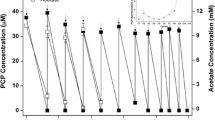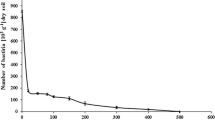Abstract
The effect of pentachloronitrobenzene (PCNB) on denitrification was assessed with two denitrifying cultures (PCNB-free control and PCNB-acclimated) developed from a contaminated estuarine sediment. PCNB was transformed to pentachloroaniline (PCA) in the PCNB-acclimated culture repeatedly amended with 0.1 μM PCNB, but further dechlorination or degradation of PCA was not observed for almost 1 year. The effect of PCNB on denitrification was also investigated with the PCNB-free control culture. PCNB at an initial concentration of 13 μM was transformed to PCA simultaneously with nitrate reduction but only after the nitrate concentration was at or below 20 mg N/l. PCNB addition at an initial concentration of 13 μM to the control denitrifying culture developed as PCNB-free culture resulted in a transient accumulation of nitric oxide (NO) and nitrous oxide (N2O). Similarly to the PCNB-acclimated culture, PCNB transformation to PCA started when the nitrate concentration decreased to about 20 mg N/l. A low degree of nitro group removal resulting in the formation of pentachlorobenzene (PeCB) was also observed in the control culture when amended with 13 μM PCNB. Further transformation or degradation of PCA was not observed in all cultures maintained under active nitrate reducing conditions. Based on the results of this study, the presence of nitrate at low concentrations in anoxic/anaerobic soil and sediments is not expected to negatively affect the biotransformation of PCNB to PCA, but dechlorination or degradation of PCA is not expected under active nitrate reducing conditions.






Similar content being viewed by others
References
Argese E, Bettiol C, Agnoli F, Zambon A, Mazzola M, Ghirardini AV (2001) Assessment of chloroaniline toxicity by the submitochondrial particle assay. Environ Toxicol Chem 20:826–832. doi:10.1897/1551-5028(2001)020
Bae HS, Yamagishi T, Suwa Y (2002) Evidence for degradation of 2-chlorophenol by enrichment cultures under denitrifying conditions. Microbiology 148:221–227
Bae HS, Yamagishi T, Suwa Y (2004) An anaerobic continuous-flow fixed-bed reactor sustaining a 3-chlorobenzoate-degrading denitrifying population utilizing versatile electron donors and acceptors. Chemosphere 55:93–100. doi:10.1016/j.chemosphere.2003.10.022
Chang BV, Zheng JX, Yuan SY (1996) Effects of alternative electron donors, acceptors and inhibitors on pentachlorophenol dechlorination in soil. Chemosphere 33:313–320. doi:10.1016/0045-6535(96)00174-9
Chen IM, Chang BV, Yuan SY, Wang YS (2002) Reductive dechlorination of hexachlorobenzene under various additions. Water Air Soil Pollut 139:61–74. doi:10.1023/A:1015861217112
Chidthaisong A, Conrad R (2000) Turnover of glucose and acetate coupled to reduction of nitrate, ferric iron and sulfate and to methanogenesis in anoxic rice field soil. FEMS Microbiol Ecol 31:73–86
Coschigano PW, Häggblom MM, Young LY (1994) Metabolism of both 4-chlorobenzoate and toluene under denitrifying conditions by a constructed bacterial strain. Appl Environ Microbiol 60:989–995
Freedman DL, Swamy M, Bell NC, Verce MF (2004) Biodegradation of chloromethane by Pseudomonas aeruginosa strain NB1 under nitrate-reducing and aerobic conditions. Appl Environ Microbiol 70:4629–4634. doi:10.1128/AEM.70.8.4629-4634.2004
Fuller ME, Manning JF (1998) Evidence for differential effects of 2,4,6-trinitrotoluene and other munitions compounds on specific subpopulations of soil microbial communities. Environ Toxicol Chem 17:2185–2195. doi:10.1897/1551-5028(1998)017
Genthner BRS, Price WAI, Pritchard PH (1989) Anaerobic degradation of chloroaromatic compounds in aquatic sediments under a variety of enrichment conditions. Appl Environ Microbiol 55:1466–1471
Gerritse J, Drzyzga O, Kloetstra G, Keijmel M, Wiersum LP, Hutson R, Matthew D, Collins MD, Gottschal JC (1999) Influence of different electron donors and acceptors on dehalorespiration of tetrachloroethene by Desulfitobacterium frappieri TCE1. Appl Environ Microbiol 65:5212–5221
Gess P, Pavlostathis SG (1997) Desorption of chlorinated organic compounds from a contaminated estuarine sediment. Environ Toxicol Chem 16:1598–1605. doi:10.1897/1551-5028(1997)016
Häggblom MM, Young LY (1999) Anaerobic degradation of 3-halobenzoates by a denitrifying bacterium. Arch Microbiol 171:230–236. doi:10.1007/s002030050704
Häggblom MM, Rivera MD, Young LY (1993) Influence of alternative electron acceptors on the anaerobic biodegradability of chlorinated phenols and benzoic acids. Appl Environ Microbiol 59:1162–1167
Häggblom MM, Rivera MD, Young LY (1996) Anaerobic degradation of halogenated benzoic acids coupled to denitrification observed in a variety of sediment and soil samples. FEMS Microbiol Lett 144:213–219
Hakala JA, Chin YP, Weber EJ (2007) Influence of dissolved organic matter and Fe(II) on the abiotic reduction of pentachloronitrobenzene. Environ Sci Technol 41:7337–7342. doi:10.1021/es070648c
Klupinski TP, Chin YP, Traina SJ (2004) Abiotic degradation of pentachloronitrobenzene by Fe(II): reactions on goethite and iron oxide nanoparticles. Environ Sci Technol 38:4353–4360. doi:10.1021/es035434j
Kostyál E, Nurmiaho-Lassila EL, Puhakka JA, Salkinoja-Salonen M (1997) Nitrification, denitrification, and dechlorination in bleached kraft pulp mill wastewater. Appl Microbiol Biotechnol 47:734–741. doi:10.1007/s002530051003
Kuhn EP, Suflita JM (1989) Sequential reductive dehalogenation of chloroanilines by microorganisms from a methanogenic aquifer. Environ Sci Technol 23:848–852. doi:10.1021/es00065a014
Kuhn EP, Townsend GT, Suflita JM (1990) Effect of sulfate and organic carbon supplements on reductive dehalogenation of chloroanilines in anaerobic aquifer sediments. Appl Environ Microbiol 56:2630–2637
Madsen T, Licht D (1992) Isolation and characterization of an anaerobic chlorophenol-transforming bacterium. Appl Environ Microbiol 58:2874–2878
Mah AR, Smith MR (1981) The methanogenic bacteria. In: Starr MP (ed) Prokaryotes: a handbook of habitats, isolation and identification of bacteria. Springer-Verlag, New York
Maithreepala RA, Doong RA (2004) Enhanced remediation of carbon tetrachloride by Fe(II)-Fe(III) systems in the presence of copper ions. Water Sci Technol 50:161–168
Mancinelli RL, McKay CP (1983) Effects of nitric oxide and nitrogen dioxide on bacterial growth. Appl Environ Microbiol 46:198–202
Middeldorp PJM, van Doesburg W, Schraa G, Stams AJM (2005) Reductive dechlorination of hexachlorocyclohexane (HCH) isomers in soil under anaerobic conditions. Biodegradation 16:283–290. doi:10.1007/s10532-004-1573-8
Milligan PW, Häggblom MM (1999) Biodegradation and biotransformation of dicamba under different reducing conditions. Environ Sci Technol 33:1224–1229. doi:10.1021/es981117e
Nelson DK, Hozalski RM, Clapp LW, Semmens MJ, Novak PJ (2002) Effect of nitrate and sulfate on dechlorination by a mixed hydrogen-fed culture. Bioremed J 6:225–236. doi:10.1080/10889860290777585
Okutman Tas D, Pavlostathis SG (2005) Microbial reductive transformation of pentachloronitrobenzene under methanogenic conditions. Environ Sci Technol 39:8264–8272. doi:10.1021/es050407+
Okutman Tas D, Pavlostathis SG (2007) The influence of iron reduction on the reductive biotransformation of pentachloronitrobenzene. Europ J Soil Biol 43:264–275. doi:10.1016/j.ejsobi.2007.03.003
Okutman Tas D, Pavlostathis SG (2008) Effect of nitrate reduction on the microbial reductive transformation of pentachloronitrobenzene. Environ Sci Technol 42:3234–3240. doi:10.1021/es702261w
Okutman Tas D, Thomson IN, Löffler FE, Pavlostathis SG (2006) Kinetics of the microbial reductive dechlorination of pentachloroaniline. Environ Sci Technol 40:4467–4472. doi:10.1021/es052103t
Okutman Tas D, Prytula MT, Mulholland JA, Pavlostathis SG (2010) Theoretical investigation of the sequential reductive dechlorination pathways of chlorobenzenes and chloroanilines. Biotechnol Bioeng 105:574–587. doi:10.1002/bit.22559
Petersen JN, Skeen RS, Amos KM, Hooker BS (1994) Biological destruction of CCl4.1. Experimental-design and data. Biotechnol Bioeng 43:521–528
Picardal F, Arnold RG, Huey BB (1995) Effects of electron donor and acceptor conditions on reductive dehalogenation of tetrachloromethane by Shewanella putrefaciens 200. Appl Environ Microbiol 61:8–12
Prasad R (1996) Sustainable agriculture and fertilizer use. Current Sci 77:38–43
Prytula MT, Pavlostathis SG (1996) Effect of contaminant and organic matter bioavailability on the microbial dehalogenation of sediment-bound chlorobenzenes. Water Res 30:2669–2680
Sanford RA, Tiedje JM (1997) Chlorophenol dechlorination and subsequent degradation in denitrifying microcosms fed low concentrations of nitrate. Biodegradation 7:425–434. doi:10.1007/BF00056426
Sherwood JL, Petersen JN, Skeen RS, Valentine NB (1996) Effects of nitrate and acetate availability on chloroform production during carbon tetrachloride destruction. Biotechnol Bioeng 51:551–557
Siciliano SD, Roy R, Greer CW (2000) Reduction in denitrification activity in field soils exposed to long term contamination by 2,4,6-trinitrotoluene (TNT). FEMS Microbiol Ecol 32:61–68
Susarla S, Masunaga S, Yonezawa Y (1996) Transformations of chloronitrobenzenes in anaerobic sediment. Chemosphere 32:967–977. doi:10.1016/0045-6535(96)00006-9
Susarla S, Yonezawa Y, Masunaga S (1997) Reductive dehalogenation of chloroanilines in anaerobic estuarine sediment. Environ Technol 18:75–83
Tamura K, Hasegawa Y, Kudo T, Yamaguchi I (1995) Isolation and characterization of PCNB degrading bacterium, Pseudomonas aeruginosa Strain I-41. J Pesticide Sci 20:145–151
U.S. Environmental Protection Agency (2003) Waste minimization priority chemicals and chemical fact sheets website (http://www.epa.gov/epaoswer/hazwaste/minimize/chemlist.htm.) Office of Solid Waste and Emergency Response, Washington, DC
Vanderloop SL, Suidan MT, Moteleb MA, Maloney SW (1999) Biotransformation of 2,4-dinitrotoluene under different electron acceptor conditions. Water Res 33:1287–1295. doi:10.1016/S0043-1354(98)00320-0
Wolin EA, Wolin MJ, Wolfe RS (1963) Formation of methane by bacterial extracts. J Biol Chem 238:2882–2886
Zumft WG (1993) The biological role of nitric oxide in bacteria. Arch Microbiol 160:253–264. doi:10.1007/BF00292074
Acknowledgments
This work was supported in part by a U.S. Geological Survey grant administered through the Georgia Water Resources Institute.
Author information
Authors and Affiliations
Corresponding author
Rights and permissions
About this article
Cite this article
Okutman Tas, D., Pavlostathis, S.G. Microbial transformation of pentachloronitrobenzene under nitrate reducing conditions. Biodegradation 21, 691–702 (2010). https://doi.org/10.1007/s10532-010-9335-2
Received:
Accepted:
Published:
Issue Date:
DOI: https://doi.org/10.1007/s10532-010-9335-2




